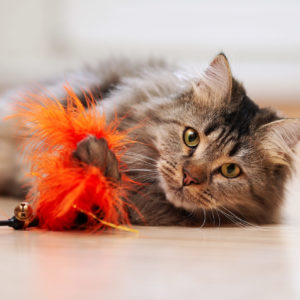It is summer in the Edmonton area, and the mixture of heat and clouds brings out some incredible thunderstorms. For some of the pets in the Morinville area, these are very stressful. It is hard to understand why your dog is afraid of a balloon, or why your cat is afraid of your grandmother. Neither of those seem scary in the least. It is a little easier to understand why pets are afraid of thunderstorms: They are loud and bright and very intimidating. Lots of people are scared of thunderstorms for the same reasons. Unfortunately, when a pet is frightened by thunderstorms, they take that fear to a level way beyond what a person would. If they are outside during thunderstorms, pets may just start running with no regard for where they are going, or how for. Even if they are in their own house or kennel, they may start shaking, drooling, or vocalizing uncontrollably. In the worst cases, thunderstorms drive cats to hide in places they cannot or will not come out of, and make dogs do destructive behaviour (digging, chewing) to get away from the noise of the thunderstorms. Out of fear, many pets forget their house training.
Dr Michael High at Morinville Vet Clinic has spent a lot of time talking with owners about how to deal with storms. “I can assure you that the most common solutions that owners have are not very helpful. The first solution is to hold the pet and comfort it. When they get this kind of close attention during thunderstorms, this only reinforces that they are showing the right behaviour to get their owner’s attention. They are being coached that they are supposed to be stressed.” On the opposite end of the spectrum, owners that punish animals for being stressed in thunderstorms are reinforcing the message that storms are a bad thing. Dr High is often consulted on how to medicate pets during thunderstorms. This might work if dogs and cats were not more sensitive than people to the signs of imminent thunderstorms. By the time an owner knows about a storm, their pet is already too stressed to be helped by tranquilizers. To be helpful, medicine would need to be given during the whole season when thunderstorms may occur. That is three months of sedation in Morinville.
What does work? The staff at Morinville Vet Clinic emphasize behaviour and training. First of all pets, especially dogs, are social animals and they get cues about danger from the people they live with. If you are stressed during thunderstorms, it increases the level of stress of dogs and cats. Second, a pet naturally responds to danger by fight or flight. No pet, not even the biggest dog, can fight thunderstorms. Their instincts tell them to run and hide. An owner can help the pet cope by providing a “safe den” during a storm. This could be a kennel covered with a towel or a dark basement where the thunder is harder to hear. If the pet is quite stressed, it is important that they not be locked in their den and feel “trapped”.
For many pets in Morinville, that is all the help they need. Of course, there are some dogs and cats that not only are afraid of thunderstorms, their fears seem to get worse with each storm. These are the pets that need help. Just as with people, dealing with fears takes time and patience.
Some pets are naturally more nervous then others, and thus more upset by loud noises like thunderstorms. These animals may be helped by natural remedies like lavender spray or Rescue Remedy supplement. There are pheromone sprays available at Morinville Vet Clinic that calm pets (D.A.P. for dogs, Feliway for cats) by mimicking the smells of a soothing social interaction. There is even a food on the market that contains ingredients known to have a calming effect on the body. A recently introduced product is the “thundershirt”, a tight fitting garment for dogs or cats that creates the feeling of being in a snug safe hiding spot. It seems to work for a lot of pets-bringing a 70 to 90 percent reduction in problem behaviours.
For some owners, the degree of stress the pet is under is unbearable. For these animals, training is required. These training techniques seem to work best for dogs, but can help cats too. The first is “counter-conditioning”. Make the thunderstorms a time when something special happens. This can be bringing out a favourite toy or serving a special food. Your pet starts to link thunderstorms with a time that something great occurs! For this to be effective, you have to start the “special event” before your pet has the stress level build to the point of distraction. The second training technique is desensitization. Desensitization is the same process in dealing with any fear: Get used to a tiny bit of the thing, then gradually get used to a little more at a time. With thunderstorms, you desensitize pets by getting a recording of thunderstorms and playing it for the pet VERY QUIETLY while playing with them. If they are not upset by the quiet noise, play it again the next day, just slightly louder. Do this in twenty-minute sessions every day. If your dog or cat shows signs of stress, turn the volume down a little. If the training works, you should be able to play the recording full volume within a few weeks, while playing with your pet. The final step is to play the recording while not distracting your pet with a game. Your dog or cat may always be afraid of thunderstorms, just not traumatized by the fear. If you are concerned about how your pet deals with storms, talk to the staff at Morinville Vet Clinic.
Written by Morinville Veterinary Clinic




